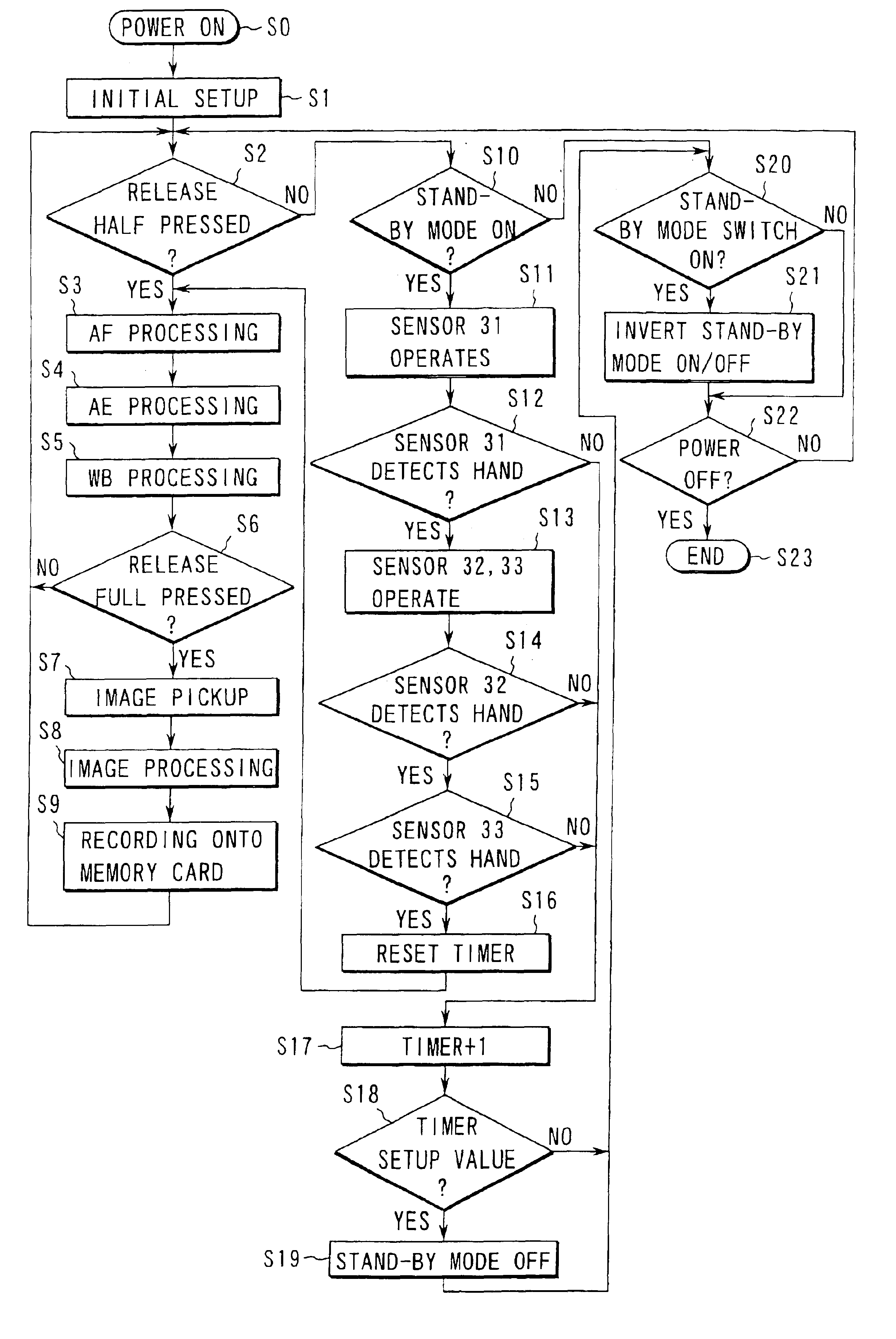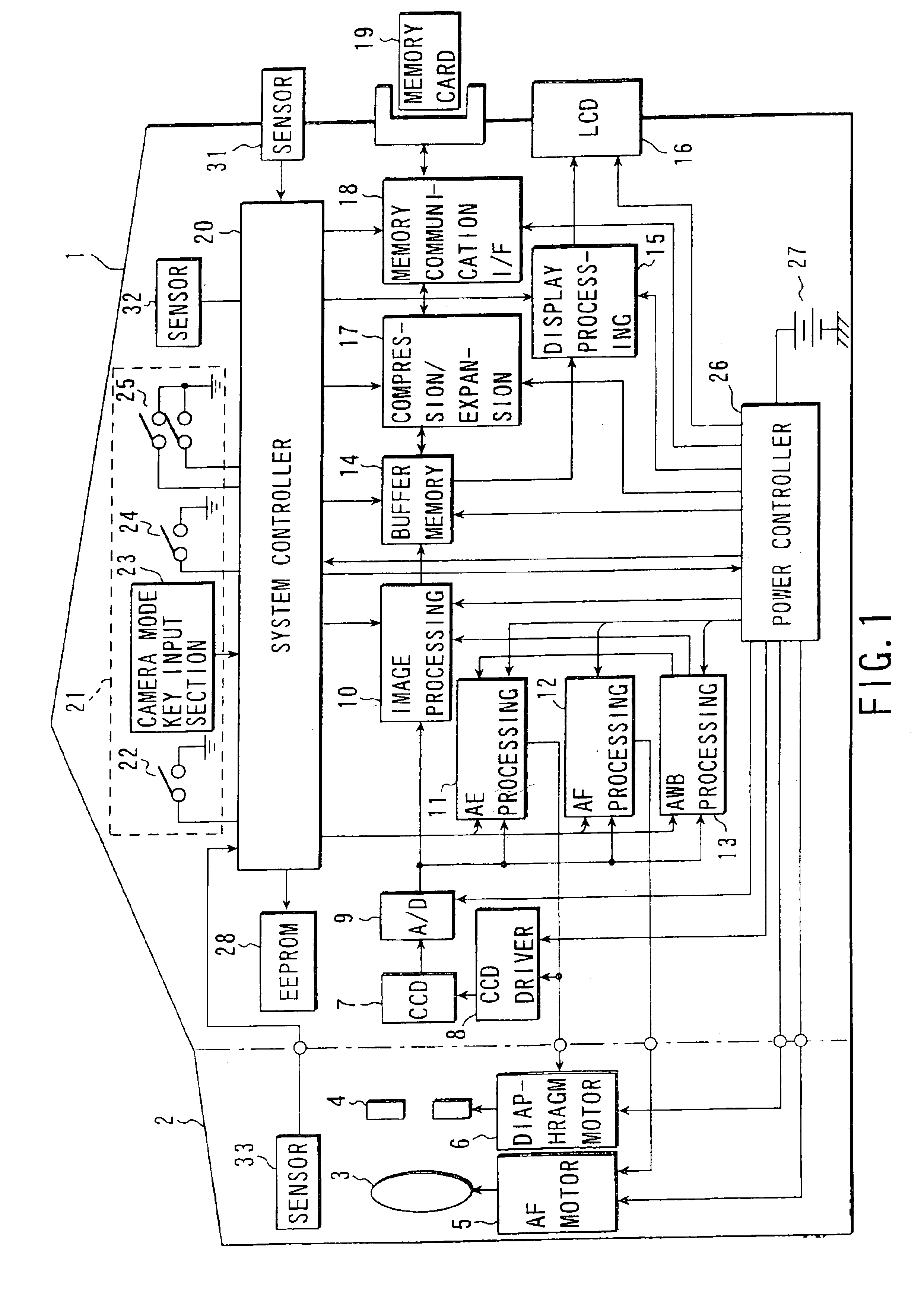Electronic camera having a standby mode for reducing delays in image pickup
a technology of standby mode and camera, which is applied in the field can solve the problems of limited capacity of battery as power source which electrically enables all the operations, weak chances of good pictures of electronic still cameras, etc., and achieve the effect of avoiding wasteful power consumption and sufficiently shortening the release time lag
- Summary
- Abstract
- Description
- Claims
- Application Information
AI Technical Summary
Benefits of technology
Problems solved by technology
Method used
Image
Examples
first embodiment
[0058](First Embodiment)
[0059]FIG. 1 is a block diagram showing the structure of an electronic still camera according to a first embodiment of the present invention. FIG. 2A is a perspective view of the electronic still camera according to the first embodiment of the present invention, and FIG. 2B is a front view thereof. This electronic still camera can roughly be divided into a camera body 1 and a lens mirror cylinder 2.
[0060]Object light passes through an image pickup lens 3 provided in the lens mirror cylinder 2 and the light amount is controlled by a diaphragm 4. The image pickup lens 3 is driven by an AF motor 5, and the diaphragm 4 is driven by a diaphragm motor 6. The object light which has passed through the image pickup lens 3 and the diaphragm 4 is introduced into the camera body 1 and enters into a CCD two-dimensional color image sensor (hereinafter referred to simply as a CCD) 7. In this manner, an object image is formed on the image pickup surface of the CCD 7.
[0061]In...
second embodiment
[0102](Second Embodiment)
[0103]FIGS. 4A and 4B show an example of layout of sensors in an electronic still camera according to another embodiment of the present invention. In the present embodiment, the sensor 31 is provided in the front surface side of the grip part of the camera body 1 and a sensor 34 is provided in the side surface side of the of the grip part. Like in the first embodiment, the sensor 32 is provided at the release button part.
[0104]The sensor 34 is thus additionally provided to respond to various ways of holding the camera. For example, when the camera is held longitudinally with the grip part situated lower as shown in FIG. 4B, the sensor 34 securely detects a hand of the user even if the sensor 31 does not detect a hand of the user. Accordingly, in the present embodiment, it is determined that the user has an intention to take a picture and preliminary operations are carried out for taking a picture if at least one of the sensors 31 and 34 is on and if the sens...
third embodiment
[0110](Third Embodiment)
[0111]FIG. 6 shows a layout example of sensors in an electronic still camera according to further another embodiment of the present invention. The present embodiment includes only the sensor 32 provided in the vicinity of the release button 35 and is characterized in that preliminary operations for image pickup are carried out if the power source is set on by the main power switch 22 and if the sensor 32 has detect contact or approach of a hand of a user.
[0112]Next, with reference to the flowchart shown in FIG. 7, explanation will be made of an example of operation for shortening the release time lag in the present embodiment. These operations are released as control by the system controller 20 and processing of the system controller 20 itself.
[0113]The processing steps S0 to S9 in FIG. 7 are the same as those in FIGS. 3 and 5. That is, when the main power switch 22 is pressed down and the power source is turned on (step S0), various initial setups are carrie...
PUM
 Login to View More
Login to View More Abstract
Description
Claims
Application Information
 Login to View More
Login to View More - R&D
- Intellectual Property
- Life Sciences
- Materials
- Tech Scout
- Unparalleled Data Quality
- Higher Quality Content
- 60% Fewer Hallucinations
Browse by: Latest US Patents, China's latest patents, Technical Efficacy Thesaurus, Application Domain, Technology Topic, Popular Technical Reports.
© 2025 PatSnap. All rights reserved.Legal|Privacy policy|Modern Slavery Act Transparency Statement|Sitemap|About US| Contact US: help@patsnap.com



